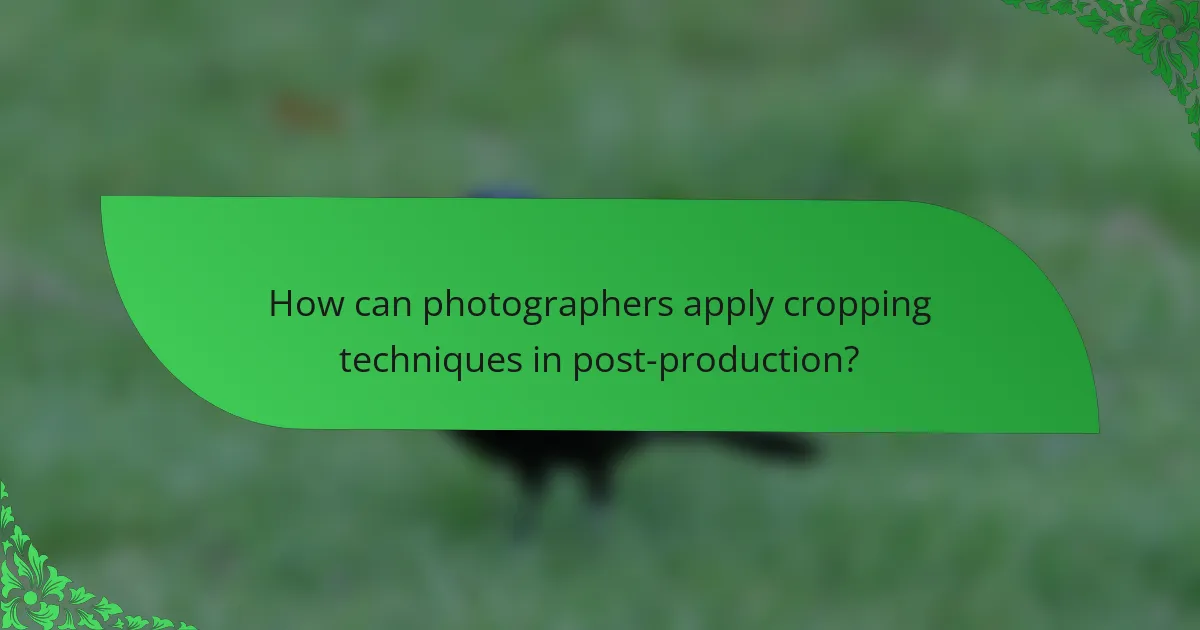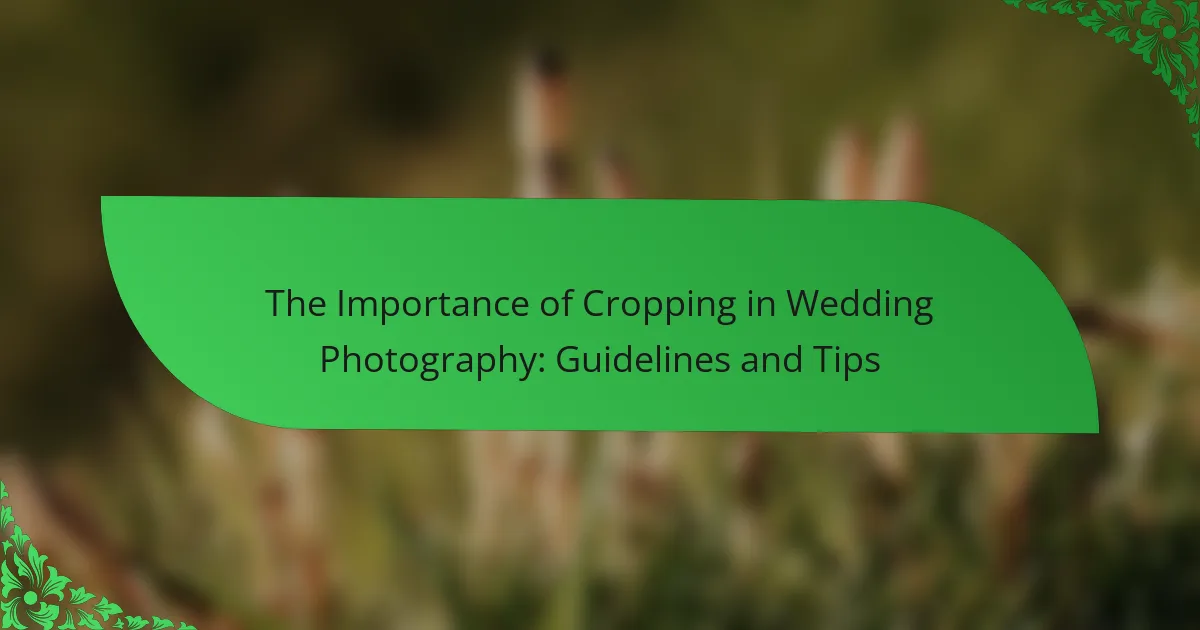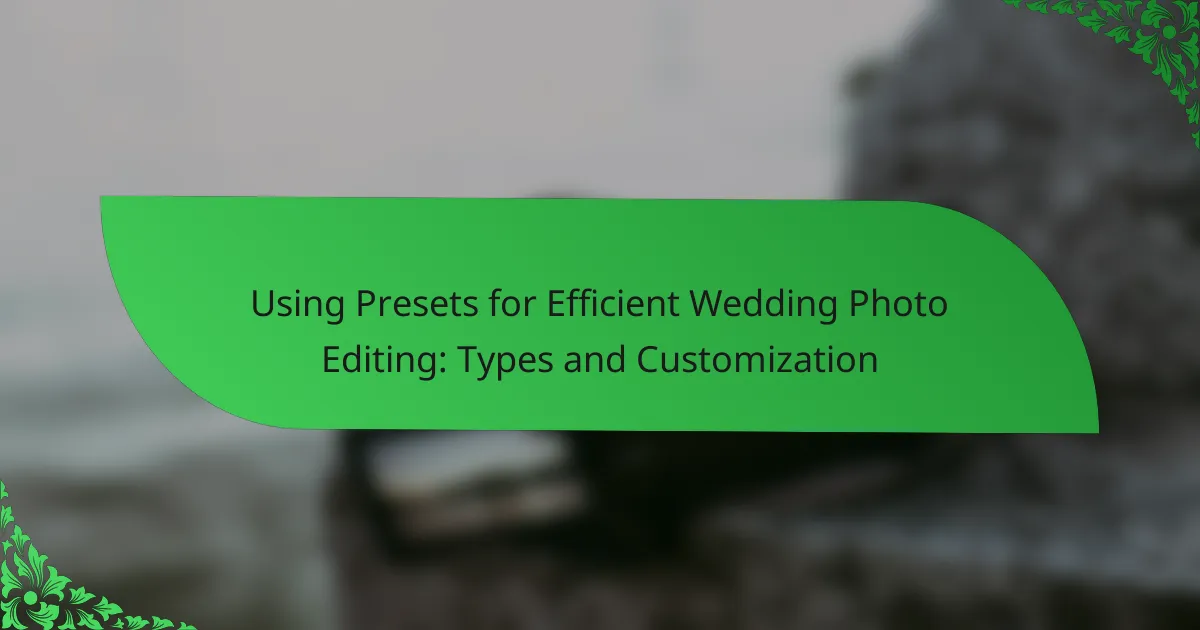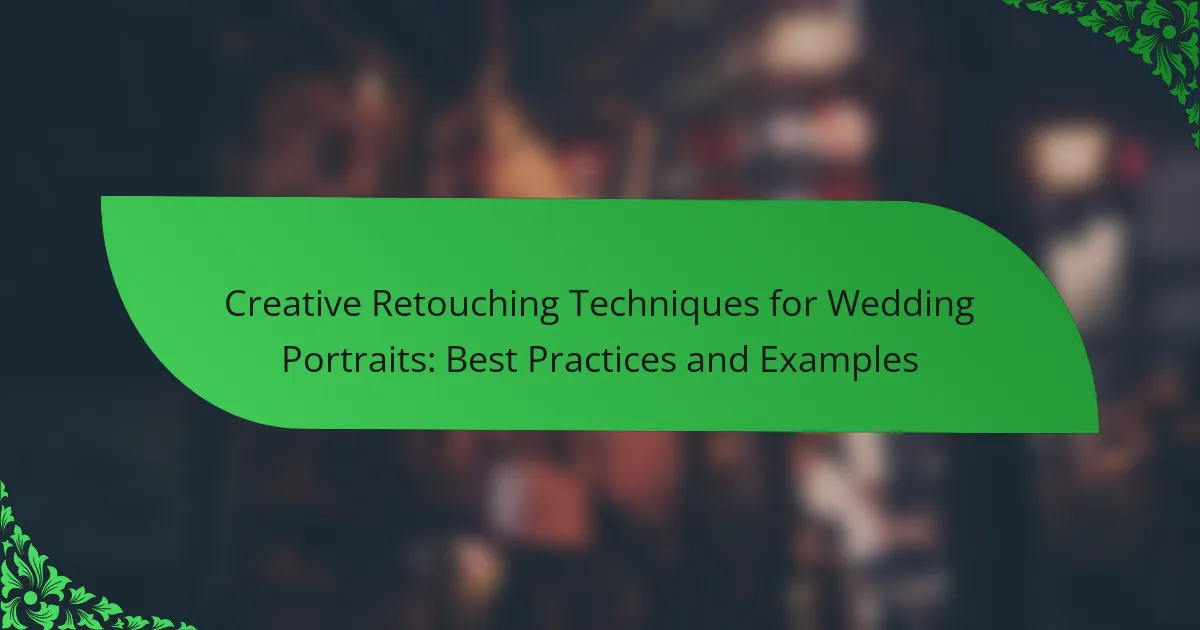Cropping is a crucial technique in wedding photography that enhances composition and emphasizes key subjects by eliminating distractions. It plays a significant role in visual storytelling and can adjust the image’s aspect ratio to meet specific format requirements. The article outlines various cropping techniques, including the rule of thirds, centering, and framing, which help draw attention to important moments. Additionally, it discusses how photographers can utilize software tools like Adobe Photoshop and Lightroom for precise cropping adjustments to improve overall image quality and client satisfaction. Understanding and applying effective cropping strategies can significantly impact the engagement and emotional resonance of wedding photos.

What is the importance of cropping in wedding photography?
Cropping is essential in wedding photography as it enhances composition and focuses on key subjects. It allows photographers to eliminate distractions from the frame. By adjusting the crop, photographers can improve visual storytelling. Proper cropping can also change the image’s aspect ratio to fit specific formats. This technique helps emphasize emotions and moments captured during the event. Studies show that well-cropped images are more engaging. Engaging images can lead to higher satisfaction for clients. Ultimately, effective cropping contributes to the overall quality of wedding photos.
How does cropping enhance the visual storytelling in wedding photography?
Cropping enhances visual storytelling in wedding photography by focusing on essential elements. It allows photographers to eliminate distractions and highlight key moments. This technique directs the viewer’s attention to emotions and interactions. Cropping can also create a sense of intimacy and connection. By framing subjects effectively, it emphasizes the narrative of the day. For instance, a close-up of a couple’s hands can convey love and commitment. Studies show that well-cropped images engage viewers more effectively. Thus, cropping is crucial for impactful visual storytelling in wedding photography.
What are the key elements of a well-cropped wedding photograph?
A well-cropped wedding photograph includes composition, focus, and balance. Composition refers to the arrangement of subjects within the frame. A good composition highlights the couple and important details. Focus ensures that the main subjects are sharp and clear. This draws attention to the couple’s expressions and emotions. Balance involves distributing visual weight evenly across the photo. A balanced image feels harmonious and pleasing to the eye. Additionally, proper cropping eliminates distractions from the background. This keeps the viewer’s attention on the couple. Effective cropping enhances storytelling by emphasizing key moments.
How does cropping impact the emotional connection of wedding photos?
Cropping significantly impacts the emotional connection of wedding photos by focusing on key moments and subjects. It allows photographers to emphasize emotions, expressions, and interactions. Effective cropping can eliminate distractions and enhance the viewer’s engagement with the image. For instance, a close-up of a couple’s joyful expression can evoke stronger feelings than a wider shot. Research indicates that images with tighter framing often lead to higher emotional responses from viewers. This is because they create a sense of intimacy and connection. Overall, thoughtful cropping transforms wedding photos into powerful storytelling tools that resonate emotionally.
Why is cropping considered a vital skill for wedding photographers?
Cropping is considered a vital skill for wedding photographers because it enhances composition and focuses on key subjects. Proper cropping can eliminate distractions from the background. It helps in framing the couple and important moments effectively. This technique also allows photographers to adjust the aspect ratio for various formats. Additionally, cropping can improve the storytelling aspect of an image. According to a study by the American Society of Media Photographers, well-cropped images significantly increase viewer engagement. Thus, mastering cropping is essential for delivering compelling wedding photographs.
What common mistakes do photographers make regarding cropping?
Photographers often make several common mistakes regarding cropping. One mistake is cropping too tightly around the subject. This can lead to a loss of context and make the image feel cramped. Another mistake is neglecting the rule of thirds. Failing to position the subject along these lines can result in unbalanced compositions. Additionally, some photographers crop out important elements, disrupting the narrative of the image. Over-cropping can also diminish image quality, especially in digital photography. Photographers may also overlook the aspect ratio, which can affect how the image fits into various formats. Finally, inconsistency in cropping styles can confuse viewers and weaken a photographer’s portfolio. These mistakes can impact the overall effectiveness of wedding photography.
How can mastering cropping techniques improve a photographer’s portfolio?
Mastering cropping techniques can significantly enhance a photographer’s portfolio. Cropping allows photographers to focus on key elements within an image. This improves composition and draws attention to the subject. Effective cropping can eliminate distractions in the frame. It can also create a more dynamic visual narrative. Photographers can use cropping to adjust aspect ratios for different platforms. This adaptability can increase the versatility of their work. Research shows that well-composed images receive higher engagement on social media. Thus, mastering cropping can lead to a more impactful and professional portfolio.

What are the different cropping techniques used in wedding photography?
The different cropping techniques used in wedding photography include rule of thirds, centering, and framing. The rule of thirds involves dividing the image into a grid and placing subjects along the lines or intersections. Centering focuses on placing the main subject in the middle of the frame for emphasis. Framing uses elements in the environment to create a natural border around the subject. These techniques enhance composition and draw attention to key moments. Cropping can also adjust the aspect ratio to fit specific formats, such as portrait or landscape. Each technique contributes to the storytelling aspect of wedding photography.
How does the rule of thirds apply to cropping in wedding photography?
The rule of thirds is a compositional guideline that enhances cropping in wedding photography. It divides the image into a 3×3 grid, creating nine equal parts. Photographers can crop images to align key subjects along these grid lines or at their intersections. This technique draws attention to the most important elements in the frame. It also creates a sense of balance and visual interest. By applying the rule of thirds, photographers can avoid centering subjects, which often leads to static compositions. This approach encourages dynamic framing, making wedding photos more engaging. Studies show that images utilizing the rule of thirds are perceived as more aesthetically pleasing.
What are some examples of effective use of the rule of thirds in wedding photos?
Effective use of the rule of thirds in wedding photos includes positioning the couple along one of the vertical lines. This creates a balanced composition. Another example is placing the horizon on the upper or lower third line. This emphasizes either the sky or the ground, enhancing the photo’s depth. Additionally, framing key moments, like the exchange of vows, at the intersection points draws attention to the subjects. Using natural elements, such as trees or arches, at the third lines can add context. These techniques lead to more engaging and visually appealing images.
How can photographers use leading lines in cropping to guide the viewer’s eye?
Photographers can use leading lines in cropping to guide the viewer’s eye by strategically framing elements within the image. Leading lines direct attention toward the main subject, creating a sense of depth and perspective. By cropping in a way that emphasizes these lines, photographers enhance visual flow. For example, a path or road can draw the viewer’s gaze toward a couple in a wedding photograph. This technique helps create a narrative within the image. The effective use of leading lines can significantly improve composition. Research shows that images with strong leading lines are more engaging and memorable. This principle is widely recognized in visual arts and photography.
What are the best practices for cropping wedding photos?
The best practices for cropping wedding photos include focusing on the subject and maintaining composition balance. Always ensure the main subjects are centered or follow the rule of thirds. Avoid cutting off important features, such as heads or hands. Use cropping to eliminate distractions in the background. Maintain a consistent aspect ratio for a cohesive album. Consider the emotional impact of the image when deciding on the crop. Finally, review the cropped image at different sizes to ensure clarity and detail are preserved.
How should photographers decide on the focal point when cropping?
Photographers should decide on the focal point when cropping by identifying the main subject of the image. The focal point should draw the viewer’s attention immediately. Photographers can use the rule of thirds to position the subject effectively. This technique involves dividing the frame into a grid of nine equal parts. Placing the subject along these lines or at their intersections enhances visual interest. Additionally, photographers should consider the surrounding elements. They need to ensure that the background complements the focal point. This approach avoids distractions and maintains focus on the subject. Ultimately, a well-chosen focal point improves the overall composition of the photograph.
What tools can photographers use to crop images effectively during editing?
Photographers can use software tools like Adobe Photoshop, Lightroom, and GIMP to crop images effectively during editing. Adobe Photoshop offers a cropping tool with customizable aspect ratios and guides. Lightroom provides a simple cropping interface with grid overlays for alignment. GIMP is a free alternative that includes a cropping feature with precise control. These tools allow for adjustments in composition and framing. They also support non-destructive editing, preserving original images. Many photographers rely on these tools to enhance visual storytelling.

How can photographers apply cropping techniques in post-production?
Photographers can apply cropping techniques in post-production by adjusting the composition of their images. Cropping allows photographers to enhance the focus on the subject. It can eliminate distractions from the background. Photographers can also change the aspect ratio to fit specific formats. For instance, a square crop may work better for social media. Cropping can improve the overall balance of the image. It can also create a stronger visual impact. Software tools like Adobe Photoshop and Lightroom provide cropping options. These tools allow precise adjustments to framing and composition.
What software options are available for cropping wedding photographs?
Adobe Photoshop offers comprehensive cropping tools for wedding photographs. It allows precise adjustments and advanced editing features. Lightroom is another popular choice, providing user-friendly cropping options. Capture One is favored by professionals for its robust image editing capabilities, including cropping. GIMP is a free alternative that also supports cropping functions. Affinity Photo offers a one-time purchase option with powerful cropping tools. Each software option is designed to enhance the cropping process for wedding photography, ensuring optimal image composition.
How do different software tools compare in terms of cropping features?
Different software tools offer varying cropping features that cater to distinct user needs. Adobe Photoshop provides advanced cropping options, including perspective correction and content-aware fill. Lightroom focuses on simplicity, offering grid overlays and aspect ratio presets for quick adjustments. GIMP, as a free alternative, includes basic cropping tools with layer management capabilities. Capture One excels in tethered shooting environments, allowing real-time cropping adjustments. Each tool’s cropping features reflect their target audience, from professional photographers to casual users. The choice depends on specific requirements, such as complexity, user interface, and additional editing capabilities.
What tips should photographers follow when cropping in post-production?
Photographers should maintain the aspect ratio during cropping. This ensures the final image fits standard dimensions for prints and displays. Use the rule of thirds to create balanced compositions. Placing subjects along grid lines enhances visual interest. Avoid excessive cropping that removes essential elements. This can lead to a loss of context in the image. Always leave some space around the subject. This allows for a more natural look and feel. Consider the resolution of the image when cropping. Higher resolutions allow for more flexibility without losing quality. Finally, review the cropped image at 100% zoom. This helps identify any loss of detail or unwanted artifacts.
What common challenges do photographers face when cropping wedding images?
Photographers face several common challenges when cropping wedding images. One challenge is maintaining the composition while removing distractions. Photographers must ensure the focus remains on the couple and significant moments. Another challenge is preserving the aspect ratio needed for prints or digital displays. Cropping incorrectly can lead to unwanted image distortion. Additionally, photographers often struggle with balancing the foreground and background elements. Effective cropping should enhance the visual story without losing essential details. Finally, the emotional context of the image can be compromised if cropping is too aggressive. These challenges require careful consideration to achieve a polished final product.
How can photographers overcome issues with composition during cropping?
Photographers can overcome issues with composition during cropping by applying the rule of thirds. This guideline suggests dividing the frame into a 3×3 grid. Placing key elements along these lines or at their intersections enhances balance. Additionally, photographers should consider the focal point of the image. Ensuring the subject remains prominent after cropping is essential. They can also utilize negative space effectively. This technique allows for a cleaner composition and directs focus to the main subject. Lastly, reviewing the cropped image in different formats can help identify any compositional flaws. Adapting the crop based on these observations leads to improved visual appeal.
What strategies can be employed to maintain image quality while cropping?
To maintain image quality while cropping, use high-resolution images as a starting point. High-resolution images contain more detail, allowing for better cropping without loss of quality. Employ non-destructive editing techniques, such as using layers in software like Photoshop. This method preserves the original image data, enabling adjustments without degradation. Maintain the aspect ratio during cropping to prevent distortion. This ensures that the image retains its intended composition. Use sharpening tools post-crop to enhance details that may have softened. Additionally, avoid excessive cropping, as this can lead to pixelation. Finally, consider using a tripod to minimize motion blur in the original shot, ensuring a clearer image for cropping.
What practical tips can enhance cropping skills in wedding photography?
To enhance cropping skills in wedding photography, practice framing subjects with intent. Use the rule of thirds to create balanced compositions. This technique involves dividing the frame into a 3×3 grid and placing subjects along the lines or intersections. Experiment with different crop ratios to find the most flattering perspectives. Crop tightly to eliminate distractions and draw focus to key moments. Review your images critically to identify areas for improvement. Use editing software to refine crops post-shoot, ensuring optimal framing. Regularly study professional wedding photographers’ work for inspiration and techniques.
The primary entity of this article is cropping in wedding photography, which is essential for enhancing composition and focusing on key subjects. The article outlines the significance of cropping in visual storytelling, emphasizing its role in eliminating distractions and improving emotional connections in images. Key elements of effective cropping, common mistakes photographers make, and various cropping techniques, including the rule of thirds and leading lines, are discussed. Additionally, best practices for cropping during post-production, tools available for effective cropping, and strategies to maintain image quality are provided to help photographers enhance their skills and portfolios.



